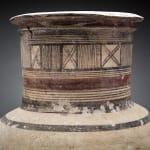Iron Age Cypriot terracotta amphora, 1200 BCE - 900 BCE
Terracotta
52.1 x 35.6 cm
20 1/2 x 14 in
20 1/2 x 14 in
FF.004
Further images
The Iron Age follows the Submycenean period (1125–1050 BC) or Late Bronze Age and is divided into the Geometric Period 1050–700 BC and the Archaic Period 700–525 BC. In the...
The Iron Age follows the Submycenean period (1125–1050 BC) or Late Bronze Age and is divided into the Geometric Period 1050–700 BC and the Archaic Period 700–525 BC.
In the ensuing Early Iron Age Cyprus becomes predominantly Greek. Pottery shapes and their decorative motives show a marked inspiration from the Aegean, although Oriental patterns creep in from time to time.
Pottery types also appear from other Mediterranean cultures as evidenced from the archaeological recovery of pottery from Cydonia, a powerful urban center of ancient Crete.
New burial customs with rock-cut chamber tombs having a long "dromos" (a ramp leading gradually towards the entrance) leading to them, along with new religious beliefs speak in favour of the arrival of people from the Aegean Sea. The same view is supported by the introduction of the safety pin that denotes a new fashion in the way people were dressed.
The 8th century BC saw a marked increase of wealth in Cyprus. Communications to the east and west were on the ascent and this created a prosperous society. Testifying to this wealth are the so-called royal tombs of Salamis, which, although plundered, produced a truly royal abundance of wealth. Sacrifices of horses, bronze tripods and huge cauldrons decorated with sirens, griffins etc., chariots with all their ornamentation and the horses' gear, ivory beds and thrones exquisitely decorated were all deposited into the tombs' "dromoi" for the sake of the deceased masters.
In the ensuing Early Iron Age Cyprus becomes predominantly Greek. Pottery shapes and their decorative motives show a marked inspiration from the Aegean, although Oriental patterns creep in from time to time.
Pottery types also appear from other Mediterranean cultures as evidenced from the archaeological recovery of pottery from Cydonia, a powerful urban center of ancient Crete.
New burial customs with rock-cut chamber tombs having a long "dromos" (a ramp leading gradually towards the entrance) leading to them, along with new religious beliefs speak in favour of the arrival of people from the Aegean Sea. The same view is supported by the introduction of the safety pin that denotes a new fashion in the way people were dressed.
The 8th century BC saw a marked increase of wealth in Cyprus. Communications to the east and west were on the ascent and this created a prosperous society. Testifying to this wealth are the so-called royal tombs of Salamis, which, although plundered, produced a truly royal abundance of wealth. Sacrifices of horses, bronze tripods and huge cauldrons decorated with sirens, griffins etc., chariots with all their ornamentation and the horses' gear, ivory beds and thrones exquisitely decorated were all deposited into the tombs' "dromoi" for the sake of the deceased masters.





